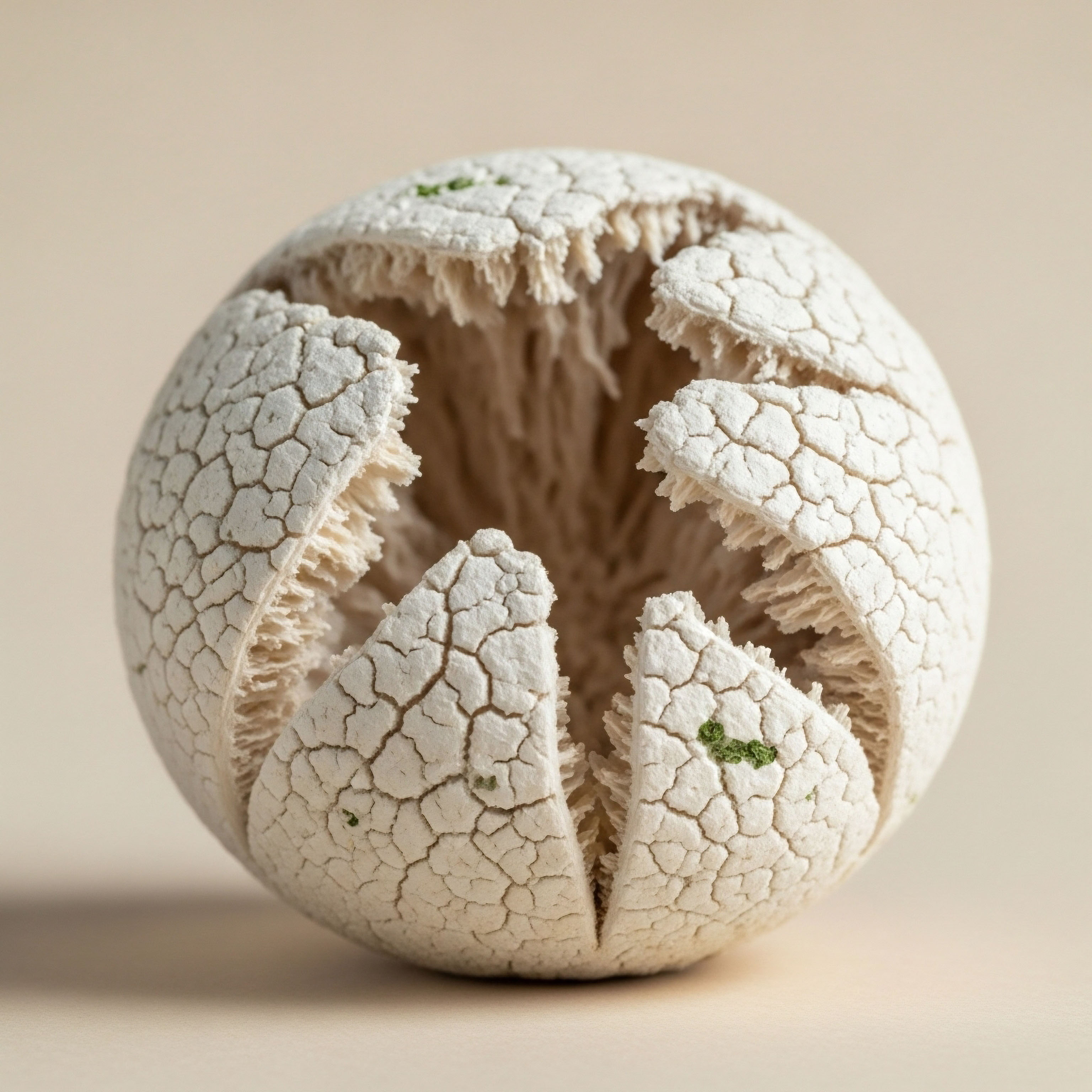

Fundamentals
You have arrived here because you are asking a sophisticated question. The desire to enhance your body’s function, to reclaim a sense of vitality that feels diminished by time, is a valid and deeply personal pursuit. You feel the subtle shifts in energy, recovery, and physical capacity.
This journey into understanding growth hormone peptide therapy begins with acknowledging the wisdom of your own body and its intricate systems. The heart, in this context, is our central focus. It is a dynamic, ever-adapting muscle, constantly remodeling itself in response to the demands placed upon it. This remodeling is a biological conversation, and growth hormone is one of its most powerful conversationalists.
Understanding the long-term implications of this therapy on your heart requires us to first appreciate the elegant system it influences. The primary mechanism is the Growth Hormone/Insulin-Like Growth Factor-1 (GH/IGF-1) axis. Think of this as the body’s master blueprint for growth, repair, and metabolism.
The pituitary gland, a small structure at the base of the brain, releases growth hormone in pulses. GH then travels to the liver and other tissues, prompting them to produce IGF-1. This IGF-1 is the powerful downstream messenger that carries out many of GH’s regenerative effects, including its influence on the heart muscle.
Peptide therapies, using molecules like Sermorelin or Ipamorelin, are designed to work with this natural system. They act as precise signals to the pituitary gland, encouraging it to produce and release your own growth hormone in a manner that mimics the body’s youthful, pulsatile rhythm. This approach is fundamentally about restoration, aiming to bring an essential biological process back into a state of optimal balance.

The Two Paths of Cardiac Remodeling
The term “cardiac remodeling” simply describes changes in the heart’s size, shape, and structure. This process follows two distinct paths, each with profoundly different outcomes for your health and longevity. Your body can embark on either path, depending on the signals it receives.

Physiological Hypertrophy the Athlete’s Heart
Physiological hypertrophy is an adaptive, beneficial form of heart muscle growth. It occurs in response to consistent, healthy stress, such as regular exercise. The heart muscle walls thicken in a balanced way, and the chamber size may increase. This allows the heart to pump more blood with each beat, making it a stronger, more efficient engine.
The individual heart muscle cells, called cardiomyocytes, grow larger and more organized. This is the remodeling you want; it is a sign of a heart adapting positively to meet a challenge.

Pathological Hypertrophy the Overburdened Heart
Pathological hypertrophy is a maladaptive, detrimental response to chronic strain. Conditions like persistent high blood pressure or a disease state like acromegaly (a condition of extreme GH excess) can trigger this process. The heart wall thickens excessively and often unevenly. A key distinction is the development of myocardial fibrosis, where supportive collagen fibers accumulate between the muscle cells.
This fibrous tissue makes the heart stiff, impairing its ability to relax and fill with blood, a condition known as diastolic dysfunction. This type of remodeling weakens the heart over time, increasing the risk of heart failure.
The GH/IGF-1 axis is the body’s core system for regulating tissue growth and repair, with direct and significant effects on the heart’s structure and function.
The entire conversation around peptide therapy and cardiac health revolves around this distinction. The therapeutic goal is to leverage the GH/IGF-1 axis to support the maintenance and healthy function of heart tissue, mirroring the state of an adaptive, athletic heart. The potential risk lies in pushing this system beyond its physiological set-point, which could initiate a shift toward pathological changes. Understanding this balance is the first principle of a responsible and effective wellness protocol.


Intermediate
Moving from the foundational concepts, we now examine the specific tools of growth hormone peptide therapy and the precise mechanisms through which they influence cardiac remodeling. The choice of peptide and the protocol design are critical variables that determine whether the influence on the heart is restorative or potentially problematic. The clinical objective is always to enhance physiological function by communicating with the body’s endocrine system in its own language.
Peptide protocols are built around molecules that stimulate the pituitary gland’s natural GH-releasing function. These are known as growth hormone secretagogues (GHS). They fall into two primary categories, each with a unique mechanism of action that can be leveraged for specific therapeutic outcomes.
- Growth Hormone-Releasing Hormone (GHRH) Analogs These peptides, such as Sermorelin and CJC-1295, mimic the body’s own GHRH. They bind to the GHRH receptor on the pituitary gland, directly stimulating the synthesis and release of growth hormone. Their action is governed by the body’s natural feedback loops, particularly the inhibitory signal from somatostatin, which prevents excessive GH release.
- Ghrelin Mimetics (GHRPs) This group includes peptides like Ipamorelin and Hexarelin. They mimic ghrelin, the “hunger hormone,” which also has a powerful secondary role in stimulating GH release. These peptides bind to a different receptor on the pituitary (the GHS-receptor). A key feature of this pathway is its ability to also suppress somatostatin, effectively taking the ‘brakes’ off GH release while simultaneously ‘pressing the accelerator’. This can lead to a more robust pulse of growth hormone.
Often, protocols will combine a GHRH analog with a ghrelin mimetic (e.g. CJC-1295 and Ipamorelin). This synergistic approach engages both pathways at once, leading to a strong, controlled pulse of GH that is still governed by the overarching endocrine system.

How Do Peptides Influence Heart Cell Behavior?
The influence of GH and IGF-1 on the heart occurs at the cellular level. When IGF-1 binds to its receptor on a cardiomyocyte, it activates a cascade of intracellular signals. The most important of these for healthy heart function is the PI3K-Akt signaling pathway.
Activation of this pathway promotes protein synthesis, leading to organized growth of the muscle fiber. It also has powerful pro-survival and anti-apoptotic (anti-cell death) effects, helping to protect heart cells from stress and damage.
The long-term implication of peptide therapy hinges on maintaining this signaling within a healthy, physiological range. A properly administered protocol that creates intermittent pulses of GH allows the cells to respond, adapt, and then rest. This pulsatility is key.
In contrast, chronically elevated levels of GH/IGF-1, as seen in acromegaly or with the use of exogenous HGH, can lead to overstimulation. This constant signaling can start to activate other pathways, like the MAPK/ERK pathway, which is more associated with the disorganized growth and inflammation seen in pathological hypertrophy. Furthermore, sustained high levels of IGF-1 can promote the proliferation of cardiac fibroblasts, the cells responsible for producing collagen, leading directly to fibrosis.
| Peptide | Mechanism of Action | Half-Life | Primary Clinical Goal |
|---|---|---|---|
| Sermorelin | GHRH Analog | Very Short (~10-12 minutes) | Mimics natural, frequent GH pulses; foundational anti-aging. |
| CJC-1295 (without DAC) | GHRH Analog | Short (~30 minutes) | A stronger, yet still pulsatile, GH release. Often combined with Ipamorelin. |
| CJC-1295 (with DAC) | GHRH Analog | Long (~8 days) | Creates a sustained elevation of GH levels, a “GH bleed.” Less physiological. |
| Ipamorelin | Selective Ghrelin Mimetic | Short (~2 hours) | Stimulates a strong GH pulse without significantly affecting cortisol or prolactin. |

What Are the Measurable Markers for Cardiac Health during Therapy?
A clinically responsible peptide protocol is one that is monitored. The goal is to verify that the therapy is achieving its intended effects without creating unintended cardiovascular strain. Several key biomarkers provide a window into the heart’s response.
First, direct markers of cardiovascular function are essential. Blood pressure and resting heart rate should be monitored regularly. An increase in either can be an early sign of excessive fluid retention or other systemic effects. Second, metabolic markers are crucial because metabolic health and cardiovascular health are inextricably linked.
This includes fasting glucose, insulin, and HbA1c to track insulin sensitivity, as high levels of GH can induce a state of insulin resistance. A comprehensive lipid panel (LDL, HDL, triglycerides) is also important. Finally, for individuals with pre-existing cardiac concerns or on long-term, higher-dose protocols, an echocardiogram can provide a direct visual assessment of the heart’s structure, measuring wall thickness and diastolic function to ensure it remains in the physiological range.
The therapeutic safety of growth hormone peptides lies in their ability to stimulate pulsatile hormone release, which respects the body’s natural feedback loops.
This intermediate understanding moves us from the ‘what’ to the ‘how’. It clarifies that the long-term cardiac implications are not a simple yes-or-no question. They are a dose-dependent, protocol-dependent, and patient-dependent outcome. The entire therapeutic strategy is predicated on using these powerful molecules to restore a physiological state, a goal that requires precision, clinical expertise, and careful monitoring.


Academic
An academic exploration of the long-term effects of growth hormone secretagogue therapy on cardiac remodeling requires a granular analysis of the molecular signaling pathways and a critical appraisal of the available clinical and preclinical data. The central issue is the differentiation between physiological cardiac hypertrophy, a benign adaptation, and pathological hypertrophy, a precursor to heart failure.
The GH/IGF-1 axis is a potent modulator of this balance, and its therapeutic manipulation must be grounded in a sophisticated understanding of its downstream consequences.
The cardiovascular system is a primary target for both GH and IGF-1, with receptors for both hormones expressed on cardiomyocytes, endothelial cells, and vascular smooth muscle cells. The physiological effects are broadly cardioprotective. GH/IGF-1 signaling enhances myocardial contractility by modulating intracellular calcium kinetics and the expression of key contractile proteins like myosin heavy chain.
It also promotes vasodilation through both endothelial-dependent nitric oxide production and non-endothelial mechanisms, contributing to healthy vascular function. In states of GH deficiency, these functions are impaired, leading to reduced cardiac mass, diastolic dysfunction, and an adverse cardiovascular risk profile, much of which is reversible with replacement therapy.

What Distinguishes Physiologic from Pathologic Hypertrophy at the Molecular Level?
The answer lies in the specific signaling cascades activated within the cardiomyocyte. Physiological stimuli, such as exercise and the pulsatile release of GH/IGF-1, predominantly activate the phosphatidylinositol 3-kinase (PI3K)/Akt pathway. This is a pro-survival, pro-growth pathway that leads to a balanced increase in cardiomyocyte size through the addition of sarcomeres in parallel, resulting in concentric hypertrophy without significant fibrosis. It is an organized and functional expansion of contractile machinery.
Pathological stimuli, such as pressure overload from hypertension or the chronic, supraphysiological levels of GH found in acromegaly, create a different signaling environment. While the PI3K/Akt pathway is still active, there is also robust activation of other pathways, including the mitogen-activated protein kinase (MAPK) cascades.
This aberrant signaling, combined with the activation of pro-fibrotic factors like transforming growth factor-beta (TGF-β), leads to a disorganized cellular growth. It also stimulates cardiac fibroblasts to excessively deposit extracellular matrix proteins, primarily collagen. This interstitial fibrosis is a hallmark of pathological remodeling. It increases myocardial stiffness, impairs electrical conduction, and leads to the diastolic dysfunction characteristic of acromegalic cardiomyopathy. The heart grows larger, but it becomes less functional.
| Feature | Physiological Hypertrophy (e.g. Exercise, Pulsatile GH) | Pathological Hypertrophy (e.g. Hypertension, Acromegaly) |
|---|---|---|
| Primary Stimulus | Intermittent mechanical load, pulsatile hormonal signals | Sustained pressure overload, chronic supraphysiological hormone levels |
| Key Signaling Pathway | PI3K/Akt activation | Sustained PI3K/Akt, robust MAPK activation, calcineurin signaling |
| Cellular Morphology | Balanced increase in cardiomyocyte size, organized sarcomere addition | Disproportionate cell growth, potential for cell elongation, apoptosis |
| Tissue Architecture | Minimal to no interstitial fibrosis | Significant interstitial and perivascular fibrosis |
| Myocardial Function | Normal or enhanced systolic and diastolic function | Initially preserved systolic function, progressive diastolic dysfunction, eventual systolic failure |

Evaluating the Evidence for Peptide Therapy
The clinical data on the long-term cardiac effects of growth hormone peptides is limited. Much of our understanding is extrapolated from two bodies of research ∞ studies on GH-deficient adults receiving recombinant human growth hormone (rhGH) and observational data from patients with acromegaly. The former generally shows that restoring GH to physiological levels improves cardiac structure and function. The latter provides a clear model of the dangers of GH excess.
Preclinical studies using animal models have provided some direct insights. For example, a study on rats undergoing resistance training found that concurrent GH administration attenuated the exercise-induced increase in cardiac collagen synthesis, suggesting a potentially protective effect against fibrosis in an adaptive remodeling context. However, other research highlights that chronic GH administration can induce concentric hypertrophy. The translation of these findings to human peptide therapy must be done with caution.
The primary argument for the relative cardiac safety of peptide secretagogues compared to exogenous rhGH is their mechanism of action. By stimulating the pituitary, they preserve the physiological feedback loop involving somatostatin. When GH and IGF-1 levels rise, the hypothalamus is stimulated to release somatostatin, which inhibits further GH release from the pituitary.
This inherent “off-switch” is a critical safeguard against the development of sustained supraphysiological levels that drive pathological remodeling. Peptides like CJC-1295 with Drug Affinity Complex (DAC), which create a prolonged “bleed” of GH, may partially bypass this pulsatility and warrant greater clinical caution and monitoring from a cardiovascular perspective.
- Unanswered Questions The precise dose- and duration-response curve for peptide therapy and cardiac remodeling in healthy, aging humans is not well established.
- Future Research Long-term, prospective, randomized controlled trials using sensitive imaging modalities like cardiac MRI with late gadolinium enhancement would be needed to definitively quantify the effects of various peptide protocols on myocardial structure, function, and fibrosis.
- Biomarker Development Identifying novel serum biomarkers that can distinguish between early physiological and pathological cardiac remodeling would be a significant clinical advancement for monitoring therapy.
The preservation of the somatostatin feedback loop is the principal mechanistic argument for the superior long-term cardiac safety profile of pulsatile peptide therapy compared to exogenous growth hormone administration.
In conclusion, the academic view is one of cautious optimism, grounded in a deep understanding of molecular mechanisms. The long-term cardiac implications of peptide therapy are entirely dependent on the ability of the clinical protocol to restore physiological signaling.
The risk profile increases as the therapy moves away from mimicking natural, intermittent GH pulses and toward creating a state of sustained, high-level GH/IGF-1 activity. The distinction is not in the molecule used, but in the biological state it creates.

References
- Colao, Annamaria. “The GH ∞ IGF‐I axis and the cardiovascular system ∞ clinical implications.” Clinical endocrinology, vol. 68, no. 4, 2008, pp. 503-11.
- Frustaci, Andrea, et al. “The GH/IGF-1 Axis and Heart Failure.” Current Cardiology Reviews, vol. 3, no. 3, 2007, pp. 202-206.
- de Boer, Harm, et al. “Long-Term Effects of Growth Hormone on Infarct Size and Left Ventricular Function in Sheep With Coronary Artery Occlusion.” Journal of Cardiovascular Pharmacology and Therapeutics, vol. 7, no. 4, 2002, pp. 215-22.
- Teixeira, Tatiane A. et al. “Effects of Growth Hormone on Cardiac Remodeling During Resistance Training in Rats.” International Journal of Cardiovascular Sciences, vol. 30, no. 5, 2017, pp. 403-411.
- Ivey, J.R. et al. “A single injection of peptide CJC-1295, a long-acting analog of GHRH, increases GH and IGF-I levels in healthy adults.” Journal of Clinical Endocrinology & Metabolism, vol. 91, no. 3, 2006, pp. 799-805.
- Sigalos, John T. and Alexander W. Pastuszak. “The Safety and Efficacy of Growth Hormone Secretagogues.” Sexual Medicine Reviews, vol. 6, no. 1, 2018, pp. 45-53.
- Picard, F. et al. “The GHRH/GH/IGF-1 axis in the heart ∞ a new therapeutic target for heart failure?” Médecine/sciences, vol. 22, no. 11, 2006, pp. 973-8.
- Laron, Z. “The essential role of IGF-1 ∞ lessons from the long-term study and treatment of children and adults with Laron syndrome.” The Journal of clinical endocrinology and metabolism, vol. 84, no. 12, 1999, pp. 4397-404.

Reflection
You have now journeyed through the fundamental principles, the clinical protocols, and the academic science behind growth hormone peptides and their relationship with the heart. This knowledge serves a distinct purpose. It transforms you from a passive recipient of information into an active, informed participant in your own health narrative. The goal was to provide a framework for thinking about these therapies, grounded in the body’s own biological logic.
The information presented here is a map, showing the different pathways the body can take. It details the mechanisms that lead toward enhanced vitality and those that lead toward dysfunction. Having this map, you can now ask more precise questions and have more meaningful conversations with your clinical guide. You can better understand the “why” behind a specific protocol and the importance of the safety measures that accompany it.
Consider the core concept of this discussion ∞ the principle of physiological balance. Your body is a system that constantly seeks equilibrium. The therapies we have discussed are at their best when they gently guide the body back toward its own innate, youthful set-point.
How does this principle of restorative balance resonate with your personal health philosophy? The ultimate goal of this knowledge is not to provide all the answers, but to empower you to ask the right questions on your path to reclaiming your full potential.

Glossary

growth hormone peptide therapy

growth hormone

ipamorelin

sermorelin

cardiac remodeling

physiological hypertrophy

pathological hypertrophy

myocardial fibrosis

diastolic dysfunction

heart failure

peptide therapy

igf-1 axis

somatostatin

cjc-1295

ghrh analog

cardiomyocyte

growth hormone secretagogue

igf-1 signaling

pi3k/akt pathway




